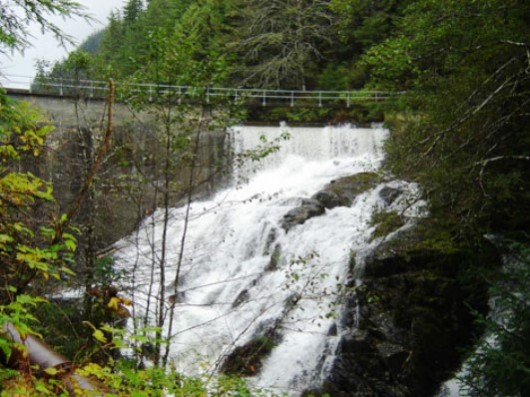Construction-related blasting up at Ketchikan’s Whitman Lake hydroelectric dam site triggered a landslide Saturday, taking out two pipes that supply water for the Whitman hatchery.
To keep you from worrying: The fish are OK. But, it was touch and go there for a while.
“Worst-case scenario for a hatchery. We lost both pipelines,” said Bill Gass, the production manager up at the Whitman Lake hatchery.
He said the accident ended up cutting off all the water for the hatchery, and as one might imagine, water is kind of important to the business.
“Water is everything to a fish,” he said. “Our normal operating capacity at this time of year would be 9,000-10,000 gallons a minute flowing through the hatchery. Without a water supply, your hatchery is nothing.”
Quick action, a lot of trips to haul water, and a long night spent clearing debris from the pipes saved the vast majority of the developing salmon. Gass said they usually lose about 200 a day at the fry stage, anyway, and the mishap might have increased that daily loss to 1,000. That’s out of about two and a half million.
“These are kings and cohos,” he said. “There’s about a million Chinook; 750,000 will be released at Whitman Lake and another 250,000 go to Neets Bay.”
And 1.4-million coho, slated for release in various locations.
Jennie Holstrom is the City of Ketchikan’s project engineer for the Whitman dam construction. She explains what happened after the mishap.
“We immediately activated our contingency plan for that situation,” she said. “We switched over to an emergency oxygen supply at the hatchery, and began setting up a system of pumps and tanker trucks to deliver water.”
She said Dawson and S&S contractors worked through the night Saturday to clear the debris and reach the pipeline. They replaced a section of one pipe, and it was operating within 24 hours after it had been severed.
The second pipe still needs to be repaired, but the hatchery can operate on one in the meantime.
Holstrom said many people contributed to keeping the hatchery operating.
“It was a long, anxious night, but we were able to keep the fish in the raceways alive,” she said. “I’m so pleased at the outcome, and the response of everybody who helped. Everybody worked together and worked very hard to keep the hatchery going. I’m very grateful and pleased.”
Gass agrees that it was stressful, and that many people contributed to keeping the fish alive.
“I think the incident occurred at about 6:00, 6:30 on a beautiful Saturday afternoon, and most of the staff was out barbecuing, or doing whatever people do at this time,” he said. “People came in and spent the night on call, stringing hose, manning pumps, doing what we could down below while Dawson put the pipe back together. Yeah. It turned out well.”
Holstrom said project officials learned a lot from the incident. While the contingency plan worked – they saved the fish, after all – they will adjust it, in case it’s needed again.
And that is a possibility.
“We do have more excavation and blasting to do,” Holstrom said. “We’re looking at the area again now, but due to the terrain, there’s just no getting around it. We will review and refine our contingency plans, based on our experience last weekend, but we’ll just continue to move forward with the project.”
So it’s possible that this might happen again
She said, “We’ll do everything we can to prevent it, but there’s no way to eliminate that risk entirely.”
The hatchery at Whitman Lake opened in 1978, and is operated by the Southern Southeast Regional Aquaculture Association.
The long-planned Whitman Lake hydroelectric project has been on the city’s radar since 1997, when that site was identified as the best opportunity to add power to Ketchikan’s grid. After years of planning, the city came close to abandoning the project last fall, because the construction bids came in at nearly double the estimate.
After reducing the scope of the project, though, the city eventually opted to move forward with the nearly $17 million dam.






